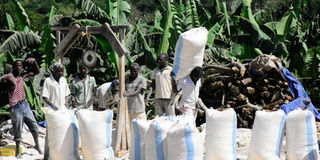The harvest is ready, are you prepared?

Farmers must use clean bags to keep their cereals after harvest. Photo by Edgar R. Batte
What you need to know:
- If insects were a problem in the previous season, a farmer should treat as soon as possible after the store is emptied. But if no problems are present, a thorough clean may be sufficient.
- According to the FAO, there are recommended fumigants and insecticides which can be used to control storage insects.
The harvest time is here and farmers should prepare grain stores paying particular attention to hygiene, to avoid costly insect and rodent infestations.
According to the Food and Agricultural Organisation (FAO) crop calendar, beans, maize and millet are being harvested or some have been harvested in areas that receive bi-modal rainfall.
The harvest should be on time as the March-May rainy season had a timely onset.
Proper cleaning after harvest coupled with good grain store management will put more income in your pocket and keep your equipment and facilities in better condition.
Michael Adubango, the manager of Nyamahasa United Area Cooperative Enterprises in Kiryandongo District, says grain store management, with a focus on preventing pest infestations is crucial.
He explains that an integrated approach is vital and if you have not already, cleaning and monitoring grain stores should be a priority.
Guarding against wastage
Post-harvest loss reduction throughout grain value chains is an important pathway to food security in sub-Saharan Africa. However, lack of understanding of the losses along the post-harvest value chains remains a major challenge to mitigating losses among smallholder farmers.
Large amounts of foods are physically lost at different stages as food commodities move across their value chains.
According to FAO, each year about one-third of all food produced for human consumption is lost world-wide.
The physical loss of food has been approximately estimated as 37 per cent or 120–170 kilogrammes per year per capita.
The World Bank estimates the value of post-harvest loss per year in sub-Saharan Africa for all grains to be about $4b, which is more than the value of food aid received in Africa over the last decade. The volume and value of these postharvest loss estimates are alarming.
This highlights the urgency to better understand and reduce postharvest food losses.
The magnitude of farm-level postharvest losses vary widely. The African Postharvest Losses Information System (APHLIS) estimates that maize post-harvest dry weight losses in Uganda from 2008 to 2016 ranged from 17.2 to 23.8 per cent.
In 2019, an estimated 413,851 tonnes of the total 2,497,644 tonnes were counted as losses amounting to 16.6 per cent. Sorghum was calculated at 12.6 per cent losses with millet at 12.3 per cent.
Maize, for instance, APHLIS estimates losses occur due to spillage at harvesting, threshing, drying, shelling, and transport to farm and during the five to eight months of on-farm storage as well as the presence of aflatoxin.
James Mugerwa, a National Agriculture Advisory Services (Naads) extension worker based in Buikwe District explains that grain store preparation is among the most crucial activities in the farming cycle.
“Farmers invest a lot of money in producing tonnes of grain only to end up losing it or diminishing its value because of poor storage yet this can be avoided,” the crop specialist says.
Mugerwa explains that storage is important in keeping grains longer in the hope of a higher price at the right time. “Farmers who do not prepare their stores in time find themselves in afix and sell at any price offered,” he says.
Good practices
The key problems are insect pests such as grain weevils, grain beetles and grain borers. Rodents, too, need to be kept out of the store.
An infestation, Mugerwa says, could mean your grain is downgraded to a lower value specification. Or worse, it could get rejected by buyers.
Cleaning all the debris off walls, roofs and cracks is an urgent matter to ensure there is no debris or loose grain that can harbour insects after the previous harvest.
The store should be cleared or swept of all unwanted debris and the debris dumped far away from the site or burned.
According to Adubango, who oversees a community grain store with a 30-tonne capacity, cleaning the store and clearing the nearby bushes cannot be ignored by any farmer.
He explains that to ensure an uncontaminated harvest, mouse traps and sticky traps can be used.
To monitor rodents, Adubango says that one should look out for droppings, footprints, gnawing and access points.
He explains if pest activity is identified, then a decision needs to be made on the best options for control.
He adds that particular attention should be paid to ledges, corners and areas where dust and debris accumulate.
If insects were a problem in the previous season, a farmer should treat as soon as possible after the store is emptied. But if no problems are present, a thorough clean may be sufficient.
According to the FAO, there are recommended fumigants and insecticides which can be used to control storage insects.
Although when applied at prescribed dilution, they are relatively safer, required precautions must be practiced.
According to Julius Ahagaana an agronomist at MTK Uganda, chemical pest control must be integrated into storage systems.
“Most chemicals must be applied at least two months before grains can be stored,” he cautions.
But challenges of mites, which thrive in humid conditions, require a farmer to properly dry the grain to keep them out.




